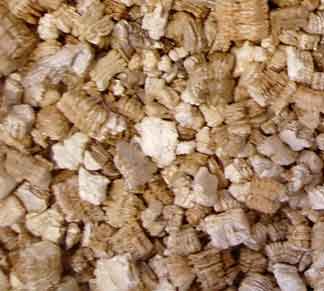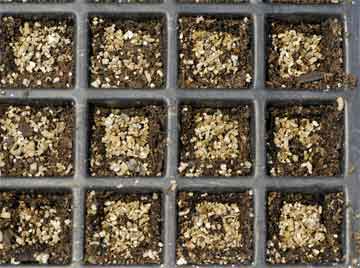Every plant professional or serious gardener sooner or later learns about the possibilities of vermiculite.
Vermiculite, a form of mica, is a soft, spongy mineral, practically worthless before being processed. Deposits are found throughout the world. In the US it has been mined in Montana, Colorado, Wyoming, Tennessee, Georgia, North Carolina, and South Carolina.
After the mineral is mined, and graded according to size, it is processed by being exposed to terrific heat. The expanding motion which follows is somewhat similar to the vermicular action of worms. It is said that Thomas H. Webb who discovered the mineral in 1824 named it “vermiculite” because of this.

Each raw chunk contains an infinite number of laminations (paper-thin sheets), as many as a million to an inch, which hold particles of water between them. Heat turns the water to steam which separates the layers. The granules expand from 12 to 15 times their original size forming thousands of dead-air spaces.
Newly mined particles resemble small, flat pieces of dark mica. Heat turns it to a silvery color. A cubic foot of the crude ore weighs around 65 pounds. A cubic foot of the expanded product weighs only six or seven pounds. Compare this with some grades of sand which weigh 100 pounds per cubic foot. This feather-weight material called “feather gold” by E. N. Alley who discovered large deposits near Libby, Montana has many uses.
Expanded vermiculite was sold under such brand names as Zonolite, Mica-Gro and Terra-lite. It is fire resistant and was used for insulation purposes, to replace sand in lightweight plaster and concrete, and as an extender in paint and bronze, as a lubricant, as packing material and other uses.
Vermiculite and Garden Uses
Our primarily interest is in its horticultural value. It is not a fertilizer and has no nutritive properties but it does condition soils, lightens heavy soil and enables sandy soil to hold moisture. It is an ideal planting medium. Because it has been exposed to 2,000 degrees or more it is completely sterile. No fungi, bacteria or other trouble makers which injure seeds can survive such heat. There are no weed seeds to annoy.
The tiny sponge-like kernels are so porous and adsorbent that they can hold many times their weight in water, yet plenty of air is trapped between the layers so that plantlets can never lack for moisture or air, both so necessary in seed growing.
As a rule it is necessary to water vermiculite only before planting thus seeds cannot become dislodged, pushed down too far, or uncovered as can easily happen if the medium needs frequent watering. Experiments have proven, also that in many instances seeds germinate in less time, and in a better percentage, and that root growth is much improved. Because the material is completely sterile, damping-off is reduced or virtually eliminated.
When replanting time comes the plants can be pulled easily with all the roots. Some of the vermiculite will cling to the rootlets. This should not be removed or shaken off but planted intact. It is because of the roots left behind in transplanting seedlings from soil that seedlings grown in vermiculite are off to a faster start.
The best medium for rooting cuttings should be one which supplies ample moisture yet does not exclude air which would cause a soggy condition ideal for rot formation. but not for root growing. Vermiculite is the perfect answer whether one is rooting African violet leaves, gloxinias, begonias, coleus, geraniums or similar plants.
Vermiculite for Storage of Bulbs
You can use it for storing root crops and bulbs. Because of its adsorptive powers (distinguished from absorptive) it takes up moisture if the root clumps are too wet, yet it will never steal it from the bulbs and cause them to shrivel.

Because of its high insulating quality, it prevents dangerous fluctuation in the soil temperature and is ideal to use in cold frames where half-hardy perennials are heeled in for the winter, and for covering potted bulbs which have been plunged in frames for later winter forcing. Vermiculite may be placed around clay pots set in fancy containers this prevents too rapid drying out.
There will be no water spillage when arranging flowers if moist vermiculite, pressed into the container, is used. Small flowers remain erect and in 1 place.
Any vermiculite which has been used for starting seeds, cuttings, in vases, and other purposes but is no longer fresh and sterile should not be wasted… mix it with soil in seed frame, or as mulch around some treasured plant. It does not deteriorate, rot or become moldy, and is as effective for this as some fresh from a new bag.
If it is desired to have a planting medium containing plant food, one may add fertilizer to the water with which the vermiculite is moistened. When starting seeds that will not require transplanting for some time, fill the flower pot or flat with soil up to within an inch of the normal level. Then add an inch of vermiculite and plant the seeds on this.
The seeds have all the advantages and protection of a vermiculite seed bed in their early stages of growth. As soon as the roots reach the soil layer they have a pantry of plant food at hand. The granules of expanded vermiculite can be made powder fine by rubbing them when dry through a fine screen. If vermiculite is firmed, com- pressed or tamped when wet it becomes greasy and worthless for most purposes. Vermiculite has been a long time and worthwhile garden helper.
